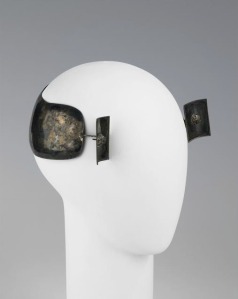Yes, this headdress is called an oorijzer, Dutch for “ear iron”.
The Oorijzer is unique to the Netherlands and is an important element of national costume and tradition. It began a as humble accessory, a type of peasant jewelry worn by the women in northern Netherlands in an area called Friesland. First created to secure expensive lace skullcaps from the gusts of strong sea winds, the simple iron band developed into an ornate headdress, serving to displaying family wealth in the form of precious metals and detailed filigree.
According to The Metropolitan Museum of Art, “the shape and style of the ornaments were indicative of their status, their husband’s or son’s profession, their locality, or even their religion. This example, also pictured with the traditional lace cap is made of brass, as opposed to the more expensive silver or gold.”

The same brass ear iron with a typical Skullcap. Copyright The Metropolitan Museum of Art.
According The Victoria and Albert Museum, the Netherlands isolated location contributed to the development of the oorijzer, which varies in shape and size according to region.

Gold filigree ear iron with three sets of earrings (one shown), mid-eighteenth century. Attributed to van Loenen. Copyright the Victoria and Albert Museum.
“This oorijzer, and its accessories, are typical of Zeeland. The decorative spirals on the ends of the oorijzer are called krullen, and were often the only part which was visible when worn. They were used as a base from which to hang pairs of bellen, which hung down like earrings, either side of the face.”

Eighteen-carat gold ear iron, fourth quarter of the nineteenth century. Copyright the Metropolitan Museum of Art.

Eighteen-karat gold ear iron ornaments, first half of the nineteenth century. Copyright The Metropolitan Museum of Art.
It can be difficult to spot an oorijzer in a Dutch painting, as many women wore multiple lace caps, obscuring whatever metal was once visible. To view a collection of illustrations, paintings and photographs featuring the oorijzer, please visit Folk Costume & Embroidery. This blog post features many helpful images of the traditional Friesland costume, which includes an unusually large ear iron.
What I find most striking about the ear iron is not its practicality or the beautifully intricate bellen, but the wonderful juxtaposition of the oorijzer and the detailed lace skullcap. The soft draping and skilled handwork of the lace provides a wonderful warmth to the hard, metallic surface of the ear iron, which appears subtly through the sheerest parts of the lace. While modest and practical, the ear iron and lace cap have an alluring quality found in the study of contrasts, which is an important element to both traditional and modern design.








Want to know more about oorijzers, bellen, lace caps and all that from a real Dutch expert? visit http://www.mutsenmaker.nl this is a site in Dutch but you can also pose questions in english and French. Also fabulous lace bonnets / caps for sale – if available!
Pingback: Kapothoed to Kalamazoo | The Family Kalamazoo